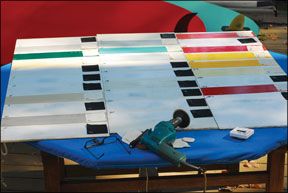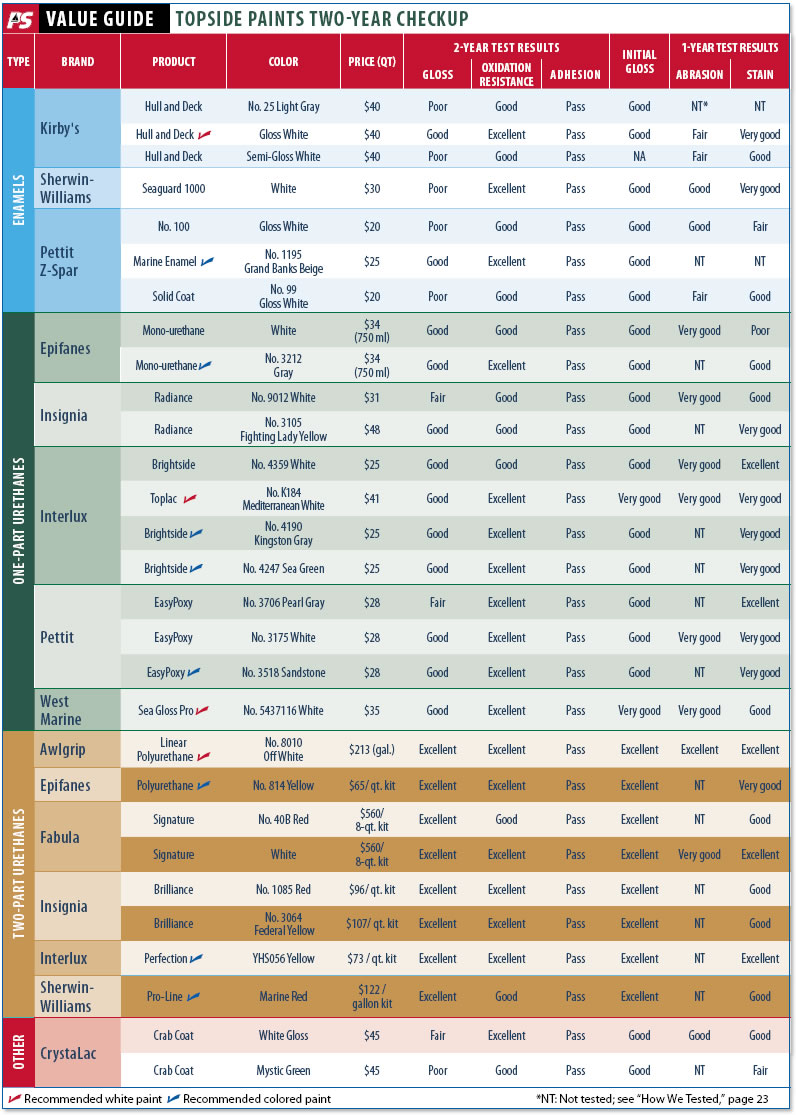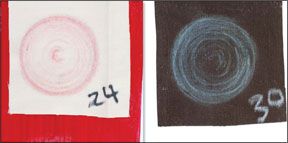
Photos by Ralph Naranjo
288
After two full years of pummeling our topside paint test panels with Maryland’s flip-flop weather combination of searing summer heat and icy, snow-encrusted winter, we’ve taken another look at how the coatings are holding up and which products are excelling. In this evaluation round, we looked at the three significant variables that most influence paint longevity: gloss, oxidation, and adhesion.
Testers reported on the application of these paints in the August 2008 issue and rated their performance at the one-year mark in the November 2009 issue. Now, at the two-year-plus point, some interesting observations can be made by comparing results from the static panel test with lessons learned from field testing the paints on various project boats. (See “Field Test Findings,” page 25.) We can validate the ruggedness of two-part coatings, reveal some important monourethane paint traits, and find a new respect for good-ole alkyd enamels.
WHAT WE TESTED
Topside paints not only come in a rainbow of colors, but their varied chemistry affords an even wider array of handling attributes and durability. Choosing the right topside paint for the job has a lot to do with matching the paint’s characteristics with your needs and application skill level.
For the last two years, Practical Sailor testers have been testing four different types of paints: traditional alkyd enamels, single-part urethane modified enamels, two-part polyurethane coatings, and a pair of water-cleanup finishes free of volatile organic compounds (VOCs). The easiest-to-apply are the traditional alkyd enamels, paints that are relatively soft, easy to sand, and almost creamy in brushability. However, the long-term gloss retention is not as good as that of the higher-tech paints.
At the other end of the topside-paint spectrum—in cost, durability, and gloss—are the two-part linear polyurethane (LPU) products. These typically afford a wet look that packs automotive showroom brilliance. The downsides are that they require more detailed surface prep and are more difficult to handle than one-part products. Riding the middle ground are one-part urethane modified enamels. These are harder, glossier, and tougher than alkyd enamels, and they are more forgiving than LPUs when applied to vertical surfaces.
Our past long-term topside paint tests have shown that when it comes to protecting the hull of a regularly used boat, the more expensive marine coatings offer better durability than the hardware store brands. So for this round of testing, we limited the test field to paints intended for the boat life. We tested products from Awlgrip, CrystaLac (Crabcoat), Epifanes, Signature Finishes (Fabula), Insignia Specialty Coatings, Interlux, Kirby’s, Pettit, Sherwin-Williams, and West Marine.
Paints from well-known marine-coatings players Epifanes, Awlgrip, and Interlux have all had good showings in past tests, and as we’ve noted, Interlux and Epifanes products tend to be more user-friendly for the DIYer. Awlgrip markets their product for pro application only and prefers not to see it in the hands of the DIY crowd. The fact that the paint is available at chandleries made us feel it was fair game for this test.
Sherwin-Williams, better known for making house paints, offers a relatively new line of marine coatings, including antifouling paints, latex enamels, and the SeaGuard 1000 alkyd enamel we tested. The CrystaLac paints were the only ones we’ve tested that are water-cleanup and touted as being more eco-friendly.
The 29 test products range in price from $20 for a quart of Pettit Z-Spar alkyd enamel to $107 for a quart kit of the Insignia Brilliance two-part LPU.

288
HOW WE TESTED
This long-term durability test, like our ongoing bottom-paint and wood-finish evaluations, is centered around a static panel test, but we’ve also selected several LPU paints and put them into real-world use, applying them to various vessels.
For the panel test, we applied each product to a carefully prepped section of a fiberglass panel. Prior to application, each panel was sanded and epoxy primed before testers applied two coats of each product, sanding between coats and using a new foam brush with each coat.
Each of the 30 paint samples has endured identical weathering, and in preparation for the annual rounds of inspection and testing, all of the swatches were washed with a mild, non-abrasive soap. All ratings in this checkup are relative to the field at the time of review.
Gloss-retention testing involved a dual objective/subjective approach. Reflected light readings were taken with a Pentax spot meter and Gossen reflected light meter; the results were averaged. These readings were taken in bright sunlight.
When it came to white or near-white surfaces, the objective approach to measuring gloss based upon the amount of light reflected by the surface had a near perfect correlation with the evaluator’s subjective findings. However, the comparisons of colored paints was not as conclusive. The meter to human eye impression had a 95-percent correlation with white and a 78-percent correlation with colored paints.
Expecting to see some oxidation on the paint panels after two years of exposure, we used a drill and rotary disk to test for oxidation buildup. Testers placed a new cotton/polyester piece of cloth on the rotary disk and moved it slowly over each coating surface for 20 seconds. The RPM was set at a no-load speed of 500; white cloth was used to test for oxidation on colored paints, and black cloth on the white coatings.
Adhesion was tested using the old painter’s standby: Testers used a scalpel to cut crosshatches through small sections of paint, creating a checkerboard surface; they placed a piece of 3M masking tape over the crosshatched surface, rubbed three times, and pulled off. Paint chips pulling away from the surface detracted from the product’s score.
In the Value Guide on page 24, you’ll also find ratings given during previous checkups: initial gloss, abrasion test results, and stain test results. For the one-year report (November 2009), testers evaluated abrasion resistance using a Scotchbrite scuff pad and 3 pounds of pressure; this test was conducted only on white paints. They used drops of dark tea (mimicking tannic acid, the culprit behind most waterline stains) to evaluate stain resistance.

288
WHAT WE FOUND
Most of the paints we tested lived up to manufacturers’ claims, and few generalizations are worth making. All products that were panel tested stood the test of time, none showed any sign of flaking or peeling, and even more astounding was the very limited amount of oxidation. The single-part urethane modified enamels stood up extremely well, and even the alkyds showed little sign of a need for a re-do. We were quite impressed by the water-based Crabcoat products, which fell a little short in the gloss category but scored high as durable, long-lived finishes.
We’ve detailed the two-year checkup results in the Value Guide on page 24. The table data offers prospective painters guidance but allows users to draw their own conclusions and decide which top-performing paint best matches their protection needs, application aptitude, and budget.
The most interesting outcome of this paint panel inspection was that all of the coatings remain tenaciously adhered to the surface after two-plus years. Part of the reason for this was the careful surface preparation that preceded the application of the topside finishes, once again proving that proper prep is key to a long-lasting finish.
The single-part urethanes proved their resilience as DIY products of choice, but for overall gloss, the two-part LPUs stole the show. The gloss on most of the traditional alkyd-enamel test panels and the water-based Crabcoat appeared dull, but even these lower-tech products retained their color well and were not chalky or overly oxidized.
ENAMELS
Gloss ratings for all of the enamel paints slipped slightly; however, the Pettit Z-Spar Marine Enamel in Grand Banks beige retained more gloss than most of the other enamels and was our testers’ favorite color among its peers. Kirby’s Hull and Deck white also rated Good for gloss at the two-year mark. CrystaLac’s Mystic green Crabcoat, one of two water-based paints we tested, held up sufficiently, and although it never had a glossy finish, it handled the weather well and retained its vibrant color. The other water-based coating, Crabcoat white gloss, did not fare as well.
Bottom line: Enamels won’t last as long as the more high-tech coatings systems, but their selling point is a super user-friendly application process. Our pick for a white enamel at this point would be Kirby’s Hull and Deck gloss white; for a color enamel, we’d go with the Pettit Z-Spar Marine Enamel in Grand Banks beige, which has an appealing look and has held up comparatively well.
MONO-URETHANES
Single-part modified urethanes offer the best blend of handleability, coverage and longevity, and they are often regarded as the best option for a DIYer.
The better-performing monourethanes at this test’s two-year mark included Interlux’s Brightside (Sea Green and Kingston Gray), and Epifanes Monourethane (Gray). West Marine’s Sea Gloss Pro (white) was another standout finish; its even hue and smooth flow out nosed it ahead of some other paints. Interlux Toplac proved to be the favorite as a glossy single-part white paint, and Pettit’s Sandstone EasyPoxy garnered the most nods as the most pleasing one-part paint color.
Bottom line: Testers’ picks in this paint category—well suited for those seeking the middle ground—are the Interlux Toplac for a single-part white paint, the Brightside coatings for those looking for a colored mono-urethane, and the Epifanes Mono-urethane gray.

288
TWO-PART LPUs
While the two-part linear poly-urethanes (LPUs) have proven to offer superior gloss retention over time, their durability, glossiness, and rock-hard finish come with trade-offs during application.
They are not as user-friendly as other types of topside paints, and as some testers found in our head-to-head paint test (August 2009) on our Catalina 22, Jelly, applying an LPU can be quite challenging for the less-experienced DIYer. By nature, LPUs are harder to handle, and the same high gloss that looks great after two years will more readily show application flaws.
Two-part paints require very careful mixing, specific brushing or spraying reducers, and are very temperature sensitive. It’s essential to keep a wet edge to cut back into in order to hide lap marks and brush strokes, but too much reducer can lead to sags and hangs. Before committing to a big project, test the paint on a smaller surface.
Interlux tries to ease the DIY applicator’s burden by providing easily accessible and helpful application tips and information on the paint cans and online—these details earn them the instruction-material extraordinaire title. Interlux walks you through the process and helps troubleshoot any application problems.
Those who would rather pay for a professionally sprayed or roll-and-tipped finish have numerous products to choose from. However, the cost of a paint job doesn’t vary much based on the paint chosen, and it’s our opinion that the best bet for those in the market for a long-lived glossy finish remains Awlgrip’s aliphatic polyester urethane. It’s the benchmark of the industry, and the product delivers stellar results.
Other top-notch two-parts in this test so far are Epifanes Poly-urethane (#814) yellow, which got testers’ recommendation in PS’s 2000-2004 panel test, and Interlux Perfection yellow, the company’s replacement for Interthane, another 2004 top pick. The inexpensive Sherwin-Williams Pro-Line also performed well.
Bottom line: Boat owners who are willing to go the extra application mile for a long-lived, glossy finish, should consider AwlGrip No. 8010. If you’d rather a stand-out color, we recommend the Epifanes yellow, Sherwin-Williams ProLine red, or Interlux Perfection yellow.
CONCLUSION
With careful preparation and application, a topside paint job can turn a worn-out hull into one that’s nearly showroom ready. A fresh coat of paint can significantly up a boat’s “wow” factor and also helps extend the life of an old boat’s gelcoat.
Developing a deft hand with a brush and roller is well within a do-it-yourselfer’s reach. With patience, careful preparation, and attention to detail, a respectable finish can be achieved. It will not be identical to the work of an experienced pro, but the more time you spend painting trim, dinghies, and decks, the more prepared you will be to handle the challenge of large vertical surfaces.
An important factor in a successful paint job is selecting the right type of paint for you and your boat. Boat owners who plan to refresh the topsides every few years may want to consider an inexpensive, easy to apply alkyd enamel. We recommend Kirby’s Hull and Deck for white hulls and Pettit Z-Spar Marine Enamel for those who want a bit of color.
Amateur topside painters looking for a more durable finish without sweating a detailed application routine would do well to choose one of the top single-part mono-urethanes. Testers tapped the Interlux Toplac for those seeking a white paint, and for a colored single-part paint, we recommend Epifanes Mono-urethane (3212), Interlux Brightside (Sea Green and Kingston Gray), and the Pettit EasyPoxy in Sandstone.
For boat owners contemplating a professionally sprayed or roll-and-tipped finish, we recommend Awlgrip. DIYers who are looking for long-lasting gloss and are up to the application challenge of a two-part LPU should consider Epifanes Poly-urethane, Interlux Perfection, or Sherwin-Williams ProLine.







































